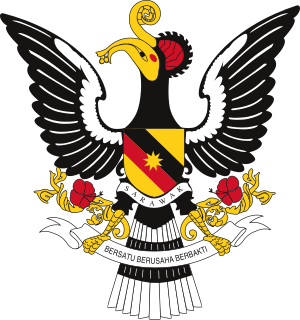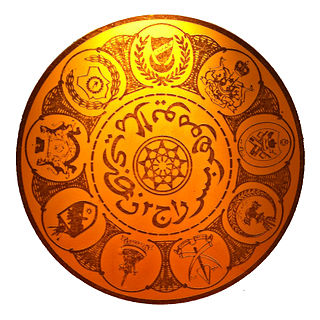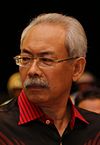Yang di-Pertuan Negara, translated from Malay as "(he) who is Lord", is a title for the head of state, and has been used as an official title at various times in Sabah, Singapore and Brunei, not to be confused with the four non-monarchical heads of Malaysian states known as Yang di-Pertua Negeri, nor the head monarch of Malaysia who is known as the Yang di-Pertuan Agong.

The Yang di-Pertuan Agong, also known as the Supreme Head or the King, is the constitutional monarch and head of state of Malaysia. The office was established in 1957, when the Federation of Malaya gained independence from the United Kingdom. Malaysia is a constitutional monarchy with an elected monarch as head of state. The Yang di-Pertuan Agong is one of the few elected monarchs in the world.
The Yang di-Pertua Negeri is the official title of the ceremonial governors of the Malaysian states without monarchs, namely Penang, Malacca, Sabah and Sarawak. They are appointed to renewable four-year terms by the Yang di-Pertuan Agong, the federal head of state of Malaysia, after consulting the Chief Minister. A Yang di-Pertua Negeri is entitled to the style Tuan Yang Terutama (T.Y.T.), or in English, His Most Excellency.
The Malay language has a complex system of styles, titles and honorifics, which are used extensively in Brunei, Malaysia, and the southern Philippines.

Judiciary of Malaysia is largely centralised despite Malaysia's federal constitution, heavily influenced by the English common law, as well as Islamic jurisprudence.

The Yang di-Pertua Negeri of Sarawak, also known as the Governor of Sarawak, is the ceremonial head of state of the Malaysian state of Sarawak. The Yang di-Pertua Negeri is styled Tuan Yang Terutama.

Sabah State Mosque or Masjid Negeri Sabah is the state mosque of Sabah, located at Sembulan roundabout between Jalan Mat Salleh and Jalan Tunku Abdul Rahman in Kota Kinabalu, Sabah, Malaysia.

This article lists important figures and events in Malayan and Malaysian public affairs during the year 1963, together with births and deaths of significant Malaysians. The Federation of Malaya merged with Singapore, North Borneo, and Sarawak to form the Federation of Malaysia on 16 September.
This article lists important figures and events in Malaysian public affairs during the year 1974, together with births and deaths of notable Malaysians.
This article lists important figures and events in Malaysian public affairs during the year 1976, together with births and deaths of notable Malaysians.

The Conference of Rulers in Malaysia is a council comprising the nine rulers of the Malay states, and the governors or Yang di-Pertua Negeri of the other four states. It was officially established by Article 38 of the Constitution of Malaysia, and is the only such institution in the world, according to the Malaysian National Library. Its main responsibility is the election of the Yang di-Pertuan Agong (King) and his deputy, the Timbalan Yang di-Pertuan Agong, which occurs every five years or when the positions fall vacant. Although its position in the process of elective monarchy is unique, the Conference of Rulers also plays a role in amending the Constitution of Malaysia and some other policies, in particular, those Articles which have been "entrenched", namely those pertaining to the status of the rulers, the special privileges of the indigenous Bumiputra, the status of the Malay language as the national language, and the clause governing the entrenchment of such Articles.

The Chief Minister of Sabah is the head of government of the Malaysian state of Sabah. Since 12 May 2018, the post has been held by Shafie Apdal from the Sabah Heritage Party (WARISAN) allied with the opposition coalition Pakatan Harapan. As in other parts of the Malaysian federation, the Westminster Parliamentary system is adopted, whereby, the leader of the party with the most seats in the state legislature would usually become the chief minister of Sabah. In other words, it is the person commanding the support of the state legislature. The chief minister is appointed by the head of state known as the Yang di-Pertua Negeri. In comparison to other states in Malaysia, the office of the Chief Minister of Sabah has been held by a more diverse group of people in terms of ethnicity and religion. The post has been held by Kadazan-Dusuns, Bajaus, Malays, Chinese, Suluks, and other persons of mixed heritage as well as being Muslims, Buddhists and Christians.

The monarchies of Malaysia refer to the constitutional monarchy system as practised in Malaysia. The political system of Malaysia is based on the Westminster parliamentary system in combination with features of a federation.
The state governments in Malaysia are the governments ruling the 13 states in the federation of Malaysia. All 13 states adopt the Westminster Parliamentary system and each has a unicameral state legislative assembly. The state government structure in all 13 states is similar to the government system of the federal government of Malaysia except for minor native judiciary powers in Sabah and Sarawak and that the state legislatures consist of only a single chamber.

The Crown Colony of North Borneo was a British Crown colony on the island of Borneo established in 1946 shortly after the dissolution of the British Military Administration. The Crown Colony of Labuan joined the new Crown Colony during its formation. It was succeeded as the state of Sabah through the formation of the Federation of Malaysia on 16 September 1963.

The Chief Minister of Sarawak is the head of government in the Malaysian state of Sarawak. The Federal Constitution and State Constitution provides that the Yang ii-Pertuan Negeri may, in his discretion, appoint any member of the State Legislative Assembly who, in his judgement, commands the support of a majority of the members of that chamber as Chief Minister. By convention, the Chief Minister is the leader of the majority party or largest coalition party of the Sarawak State Legislative Assembly.
The Sabah State Government is an authority governing Sabah, one of 13 states of Malaysia, based in Kota Kinabalu, the state capital. The state government adheres to and is created by both the Federal Constitution of Malaysia, the supreme law of Malaysia, and the Constitution of the State of Sabah, the supreme law of the State.
This is a list of events in the year 2019 in Malaysia.
Events in the year 2020 in Malaysia.















